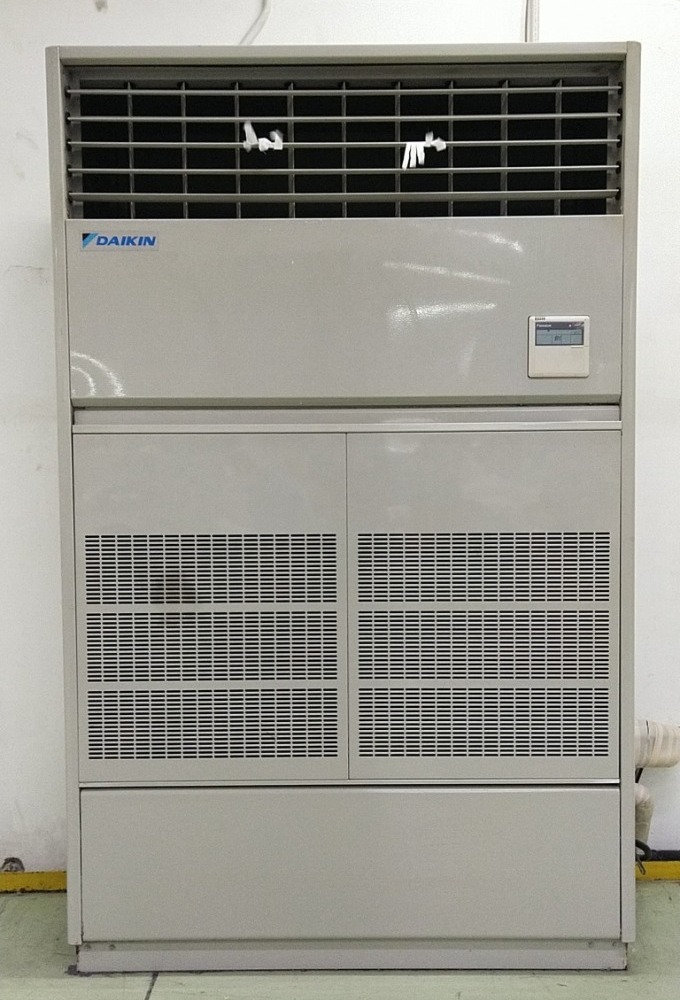Basic Concept
The Nisshinbo Group's Business Conduct Guidelines include Awareness and Concern towards its environmental impact. The Group is committed to reducing greenhouse gas emissions and providing decarbonized technologies, products, and services to faithfully realize a safe and secure society for all people.
【Main measures】
- ① The Group is advancing reduction of greenhouse gas emissions through ISO 14001 activities.
- ② The Group is advancing activities to reduce Scope1 (in-house emissions) and Scope2 (off-site emissions of electricity, etc.) at manufacturing sites, and to establish environmentally friendly facilities.
- ③ The Group is promoting new solar power generation facilities and switch to electricity derived from renewable energy sources.
- ④ In the Wireless and Communications business, the Group is offering products for adaptation to climate change. These include dam and river management systems to prevent flooding damage and disaster prevention notification and communication systems to protect local residents in the event of a disaster.
- ⑤ In the Micro Devices business, the Group is expanding equipment to reduce the emissions of PFCs gas* from semiconductor production facilities.
- ⑥ The Group is developing, manufacturing and sell ingseparator materials, core components of the fuel cells that contribute to the development of a hydrogen-based society, in the Chemicals business.
* PFCs: Fluorinated greenhouse gases used in dry etching and other processes in semiconductor manufacturing
Please refer to "Promotion System" in "Environmental Management" for the promotion system.
Specific Initiatives of The Nisshinbo Group
Assessment of the 5th Three-Year Environmental Targets (to be achieved by FY2024)
The Nisshinbo Group established the 5th Three-Year Environmental Goals (5th Sustainability Promotion Plan) with the fiscal year ending FY2024 as the target year, setting the promotion of environmental management as a priority activity and establishing the following KPIs to promote the expansion of sales of "Improvement of the sales percentage by the products that contribute to the development of the sustainable society*1" and "Reduction of greenhouse gas emissions.*2"
*1 Products that contribute to a sustainable society: Company standards
*2 Greenhouse gas emissions are targeted by Scope1+Scope2
- ① Improvement of the sales percentage by the products that contribute to the development of the sustainable society: 65% or more of sales
- ② Reduction of greenhouse gas emissions: Reduce by 35% or more compared to FY2014
Sales of the products that contribute to the development of a sustainable society accounted for 47% of the Group's FY2024 sales, falling short of the target. This was due to the inclusion of the KOKUSAI DENKI Electric Group, which began operations in FY2024, within the scope of the initiative. Products contributing to a sustainable society include semiconductor products (contributing to energy saving and smaller chip size in electrical appliances) in the Micro Devices business account for 9%, disaster prevention and mitigation-related products in the Wireless and Communications business account for 6%, non-iron shirts in the Textiles business account for 2%, which contribute to climate change action.
As a result of systematic measures to manage reductions through the PDCA cycle, the Group's greenhouse gas emissions in FY2024 were reduced by 55% compared to FY2014. The main reasons for the reduction were a decrease in greenhouse gas emissions following the transfer of the TMD Group, which was a consolidated subsidiary, and the installation of additional PFCs (perfluorocarbon) and other gas abatement equipment and reduced production in the Micro Device business.
Assessment of the 6th Three-Year Environmental Targets (to be achieved by FY2027)
In the 6th Three-Year Environmental Targets (6th Sustainability Promotion Plan) with FY2027 as the target year, we raised the KPI values based on the initiatives of the 5th term as milestones for achieving the medium-term environmental targets.
- ① Improvement of the sales percentage by the products that contribute to the development of the sustainable society: 65% or more of sales
- ② Reduction of greenhouse gas emissions: Reduce by 53% or more compared to FY2014
Please refer to "Environmental Management" for details regarding of the "3-Year Environmental Targets."
Please refer to "Sustainability Promotion Plan and KPIs" for details regarding of the "Sustainability Promotion Plan."
Greenhouse Gas Emissions Reduction Targets
The Nisshinbo Group aims to capture climate change-related business opportunities and reduce risks. In order to reduce climate-related risks, the Group declared in June 2022 to be carbon neutral by 2050 and have set a new long-term environmental target with 2050 as the year of achievement. With the achievement of carbon neutrality as its top priority, the Group actively promoting climate change countermeasures such as energy conservation activities, switching to electricity derived from renewable energy, and reducing emissions of PFCs (perfluorocarbons).
The Nisshinbo Group's Greenhouse Gas Emissions Reduction Targets
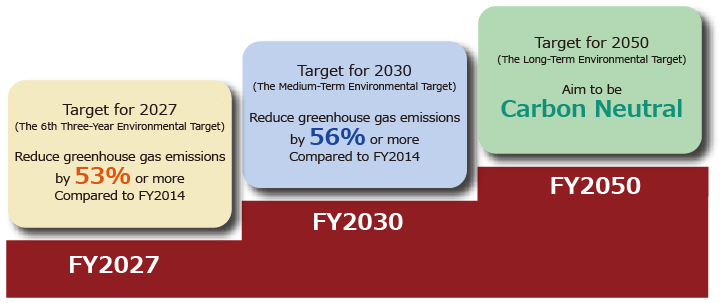
In light of the steady progress in reducing greenhouse gas emissions, the Group revised its medium-term environmental target for greenhouse gas emissions at the meeting of the Board of Directors in October 2024 and raised the target from a 50% reduction compared to 2014 to a 56% reduction.
Please refer to "Environmental Management" for the progress of The Group's Environmental Targets.
Outline of TCFD Response
Climate change is a global challenge for all countries and regions, and the reduction of greenhouse gases is a global long-term target. The Nisshinbo Group believes that it is crucial to incorporate business opportunities caused by climate change and appropriately respond to risks. Accordingly, in FY2021 the Group began analyzing climate change scenarios in accordance with the recommendations of the Task Force on Climate-related Financial Disclosure (TCFD)*1. In June 2022, the company expressed its agreement to the TCFD recommendations.
Since the Nisshinbo Group has a wide range of businesses, a climate change scenario analysis was conducted in stages starting in FY2021, and an analysis of the Group's major businesses was completed*2 in FY2023.
In FY2021, the Group targeted the Solutions business in the Wireless and Communications business, the Automobile Brakes business, and the Chemicals business that are expected to have a large risk/opportunity impact. In FY2022, the analysis was conducted in major businesses with production activities by covering the Marine System, ICT/Mechatronics, and Mobility business in the Wireless and Communications business, the Micro Devices business, the Precision Instruments business, and the Textiles business. For FY2023, the scope of the program includes Medical Equipment business in the Wireless and Communications business, Real Estate business, and Other businesses, as well as initiatives in the Business Development Division. Through climate change scenario analyses, the Group will identify the risks and opportunities that climate change may pose to the business in future, develop more flexible and robust strategies by leveraging the opportunities in the development of business strategies, and increase the resilience against future risks.
*1 TCFD: The Task Force on Climate-related Financial Disclosure established by the Financial Stability Board (FSB)
*2 Excluding KOKUSAI DENKI Electric Group, which became a subsidiary in December 2023.
Please refer to "Information Disclosure Based on TCFD Recommendations" for details regarding of the "Results of climate change scenario analysis."
Independent Practitioner's Assurance of Environmental Data
The Nisshinbo Group obtained independent practitioner's assurance from Deloitte Tohmatsu Sustainability Co., Ltd. in its Nisshinbo Group Greenhouse Gas Emissions Data 2024 in the Japanese version to improve the reliability of its Greenhouse Gas Emissions (Scope1, Scope2) environmental performance data.
Greenhouse Gas Emissions
The Nisshinbo Group's greenhouse gas emissions (Scope1 + Scope2) in FY2024 were 307.9 thousand t-CO2e. Greenhouse gas emissions after applying the carbon offsets (Net greenhouse gas emissions) amounted to 305.0 thousand t-CO2e, down 17% from the previous fiscal year's greenhouse gas emissions.
PT. Nikawa Textile Industry (Indonesia), Textiles business, has stopped using coal boilers and eliminated the use of coal as of November 2021, and three bases in Indonesia, including the company, gradually switched all electricity purchases to electricity derived from renewable energy sources, such as geothermal power, from mid-2022.
In FY2024, GHG emissions decreased further due to the transfer of the TMD Group, which was a consolidated subsidiary, and the expansion of PFCs and other gas abatement equipment and production cuts in the Micro Devices business.
Furthermore, Nisshinbo Automotive Manufacturing Inc. (USA) purchased carbon credits (Project Name: A-Gas V12, Project ID: ACR869) certified by the American Carbon Registry (ACR) and offset 2.9 thousand t-CO2e.
Perfluorocarbons (PFCs) composed 71% of non-energy related greenhouse gas emissions. The PFCs emissions were mainly from the semiconductor product manufacturing process in the Micro Devices business.
The Nisshinbo Group's actual greenhouse gas emissions (Scope 3) in FY2024 were approximately 1,305 thousand t-CO2e, down 32% from the previous fiscal year's greenhouse gas emissions. This was mainly due to the transfer of the TMD Group on November 30, 2023.
Please refer to "Environmental Data" in "Sustainability Data" for details on Scope 3, which consists of 15 categories.
Trends in Net Greenhouse Gas Emissions(Scope1+Scope2)
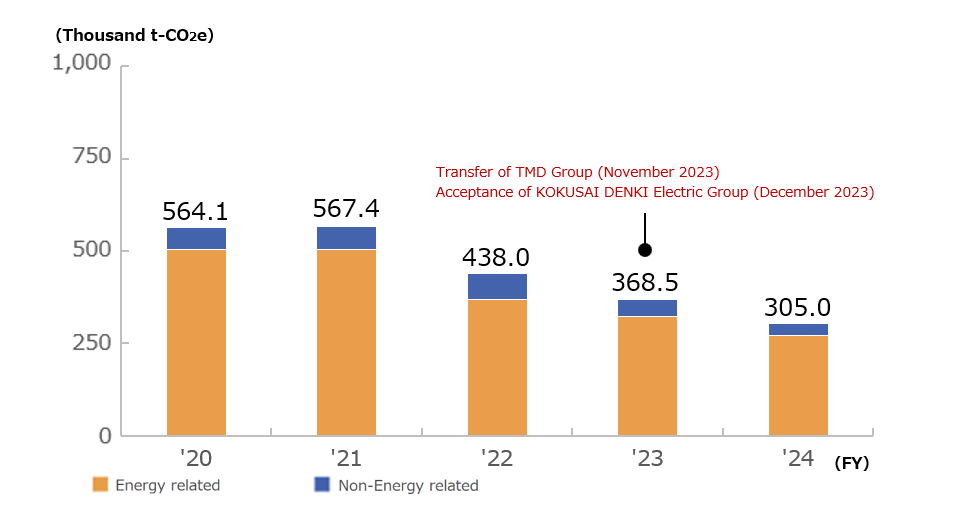
*1 The company was excluded from the scope of consolidation because of the transfer of the TMD Group, which was a consolidated subsidiary, on November 30, 2023. Therefore, the TMD Group's data up to November 2023 is included in the scope of consolidation.
*2 On December 27, 2023, the company included the Kokusai Denki Electric Group within its scope of consolidation, and data aggregation will be conducted from FY2024.
*3 On November 28, 2024, Argonics GmbH and Argonav GmbH as subsidiaries in the wireless and communications business were included within the scope of consolidation but are not included in the data for FY2024.
Greenhouse Gas Emissions by Scope(Scope1+Scope2)
(Thousand t-CO2e)
| 2020 | 2021 | 2022 | 2023 | 2024 | |||
|---|---|---|---|---|---|---|---|
| Greenhouse Gas Emissions | Scope1 | Energyrelated | 187.7 | 173.7 | 66.7 | 63.4 | 55.7 |
| Non-Energyrelated | 59.0 | 64.2 | 67.9 | 45.9 | 33.6 | ||
| Energyrelated + Non-Energyrelated |
246.7 | 237.9 | 134.6 | 109.3 | 89.3 | ||
| Scope2 | Energyrelated | 317.4 | 329.4 | 303.4 | 259.2 | 218.6 | |
| Scope1 + Scope2 |
Gross GHG emissions |
564.1 | 567.4 | 438.0 | 368.5 | 307.9* | |
| Amount of carbon offsets applied |
– | – | – | – | 2.9 | ||
| Net GHG emissions |
564.1 | 567.4 | 438.0 | 368.5 | 305.0* | ||
* Data on greenhouse gas emissions(Scope1+Scope2)are assured by a third party (Deloitte Tohmatsu Sustainability Co., Ltd.).
[Calculation Standard]
The Nisshinbo Group has changed its calculation standards from FY2024.
Until FY2023, calculations were primarily based on the Act on Promotion of Global Warming Countermeasures (Japanese Law).
From FY2024 onward, calculations are primarily based on the GHG Protocol, with reference to the Act on Promotion of Global Warming Countermeasures.
[Calculation Method]
・Scope1:
Energy related Greenhouse Gas Emissions = Σ[Fuel Consumption × CO2 Emission Factor*1]
Non-Energy related Greenhouse Gas Emissions = Non-Energy related CO2 Emissions + Σ [Greenhouse Gas Emissions other than CO2 × Global Warming Potential*2]
*1 Emission factors based on the Act on Promotion of Global Warming Countermeasures are used. Coal, however, uses a factor calculated based on actual calorific values, which is 1.870 t-CO2/t in FY2024.
*2 Global warming potential based on the Act on Promotion of Global Warming Countermeasures.
・Scope2:
Energy related Greenhouse Gas Emissions = Σ [Purchased Electricity and Purchased Steam Volume × CO2 Emission Factor*3]
*3 Purchased electricity uses, in Japan, adjusted emission factors for each electric company based on the Act on Promotion of Global Warming Countermeasures, and in foreign countries, the emission factors for each electric company, and if unavailable, the relevant year country-specific emission data of IEA Emissions Factors. Data for FY2021 and earlier use country-specific emission factors for each year from "IEA Emissions Factors 2021". For purchased steam, the emission factor calculated by the purchasing company (0.0526 t-CO2/GJ in FY2024) is used.
【Subject Organizations】
In FY2024, the Nisshinbo Group consists of 88 companies, including the Company and 87 consolidated subsidiaries. However, as noted in *3 of the net greenhouse gas emissions trend, the data for ARGONICS GmbH and ARGONAV GmbH is not included in the FY2024 data.
In greenhouse gas emissions by business, the Micro Devices business accounted for 38% of total emissions. This was followed by the Precision Instruments business, which accounted for 19%.
Greenhouse Gas Emissions by Business (Scope1+Scope2)
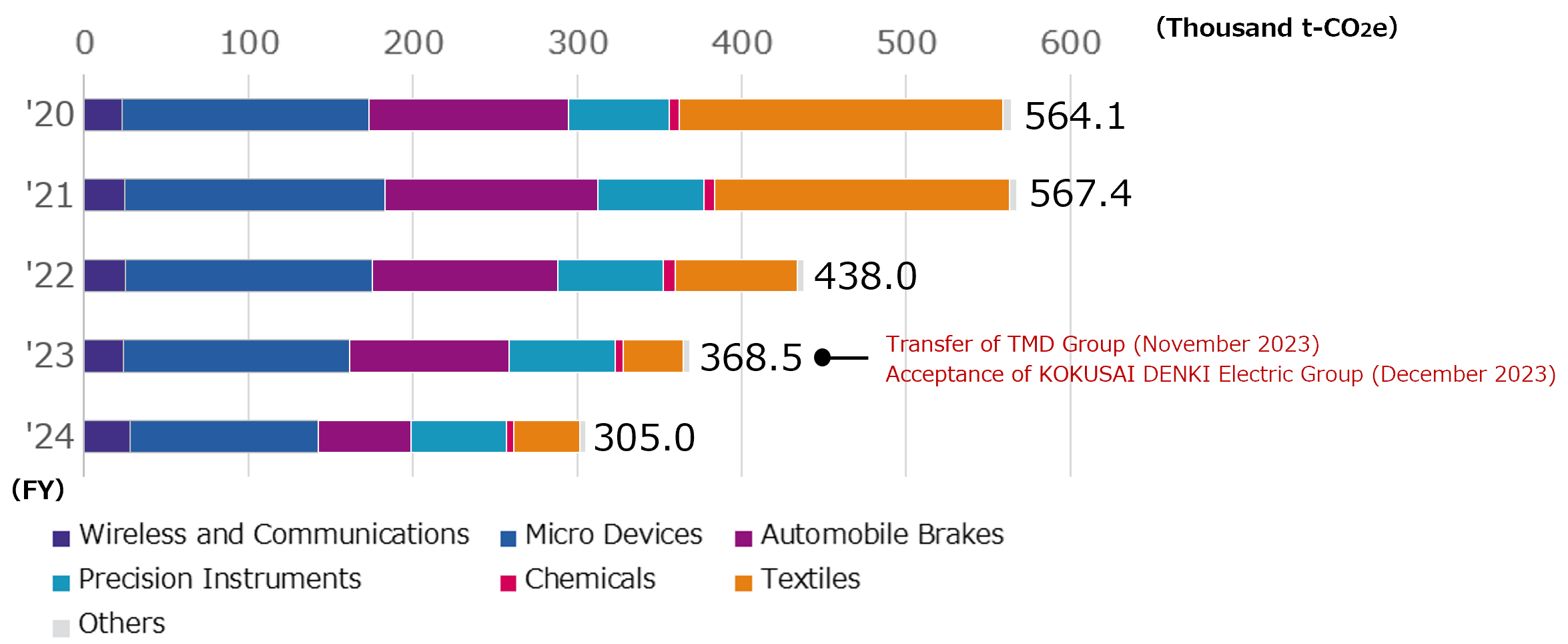
*1 Nisshinbo Holdings Inc. (the "Company") excluded TMD Group, which was a consolidated subsidiary, from the scope of consolidation, due to its transfer, which took place on November 30, 2023. As a result, data for TMD Group is included in the aggregation up to November 2023.
*2 On December 27, 2023, the Company included KOKUSAI DENKI Electric Group within its scope of consolidation, and data for the group is included from FY2024.
*3 On November 28, 2024, the Company included ARGONICS GmbH and ARGONAV GmbH within the scope of consolidation as subsidiaries in the Wireless and Communications business. However, data for these companies is not included in the FY2024 data.
Of the Nisshinbo Group's greenhouse gas emissions, the proportion in Japan accounts for 57%.
Greenhouse Gas Emissions in Japan and Overseas(Scope1+Scope2)
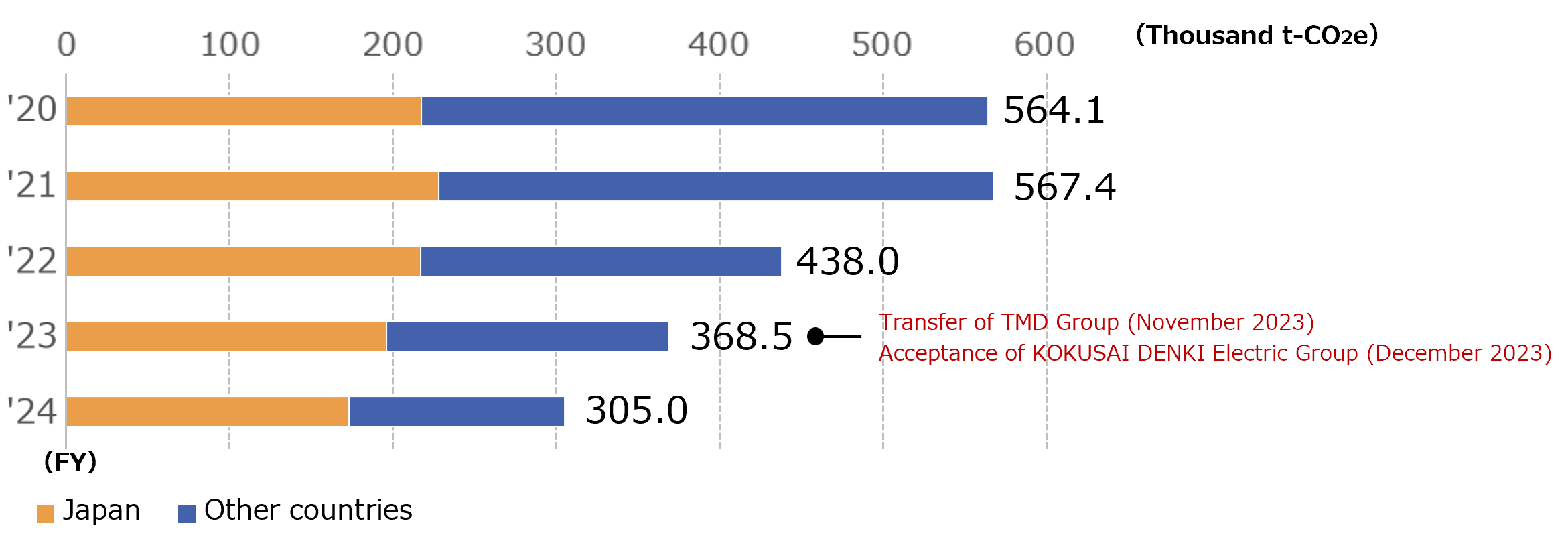
*1 Nisshinbo Holdings Inc. (the "Company") excluded TMD Group, which was a consolidated subsidiary, from the scope of consolidation, due to its transfer, which took place on November 30, 2023. As a result, data for TMD Group is included in the aggregation up to November 2023.
*2 On December 27, 2023, the Company included KOKUSAI DENKI Electric Group within its scope of consolidation, and data for the group is included from FY2024.
*3 On November 28, 2024, the Company included ARGONICS GmbH and ARGONAV GmbH within the scope of consolidation as subsidiaries in the Wireless and Communications business. However, data for these companies is not included in the FY2024 data.
Renewable Energy
The Nisshinbo Group promotes the use of renewable energy, and in FY2024, 16% of the electricity used by the Group was derived from renewable energy.
Solar Power Generation (excluding PPA*)
Solar power generation equipment installed by the Nisshinbo Group remained steady, generating 6.8 thousand MWh of power in FY2024.
Solar Power Generation Capacity (FY2024)
| Installation site | Generation capacity (kW) | Year operation commenced | Use |
|---|---|---|---|
| Nisshinbo Mechatronics Inc. Miai Machinery Plant |
430 | 2010 | Self-consumption |
| Nisshinbo Chemical Inc. Chiba Plant |
150 | 2011 |
Electric power sales, Self-consumption |
|
Nisshinbo Brake Inc. Tatebayashi Plant |
300 | 2011 | Self-consumption |
|
Nagano Japan Radio Co., Ltd. Head Office & Factory |
110 | 2013 | Electric power sales |
|
Nisshinbo Holdings Inc. Tokushima Plant |
1,750 | 2013 | Electric power sales |
| KOKUSAI DENKI Electric Inc. Tokyo Plant |
100 | 2013 | Self-consumption |
| 4 | 2015 | ||
| Nisshinbo Precision Instrument & Machinery Hiroshima Corp. | 1,000 | 2015 | Electric power sales |
| 100 | 2024 | Self-consumption | |
|
Nisshinbo Micro Device Inc. Kawagoe Works |
19 | 2018 | Self-consumption |
| Nisshinbo Micro Devices (Thailand) Co.,Ltd. | 1,300 | 2022 | Self-consumption |
| NISSHINBO SAERON (CHANGSHU) AUTOMOTIVE CO.,LTD. | 71 | 2024 | Self-consumption |
| Ueda Japan Radio Co., Ltd. Head Office & Main Factory |
70 | 2024 | Self-consumption |
| Total | 5,404 | ||
* PPA: Abbreviation for Power Purchase Agreement.
Purchase of Electricity Derived from Renewable Energy
The Nisshinbo Group is promoting the switch to electricity derived from renewable energy, and purchased approximately 98.9 thousand MWh of electricity derived from renewable energy in FY2024
The renewable energy-derived electricity purchased by the Company Group in FY2024 consists of electricity derived from geothermal power generation (71.6 thousand MWh), solar power generation (10.0 thousand MWh), wind power generation (9.0 thousand MWh), and hydroelectric power generation (8.2 thousand MWh).
Purchased Electricity from Renewable Energy Sources by Major Business Sites (FY2024)
| Segment | Company / Plant | Retailer | Category | Purchase Amount(MWh) |
|---|---|---|---|---|
| Wireless and Communications | Japan Radio Co., Ltd. Nagano Plant |
Chubu Electric Power Miraiz Company, Incorporated | Hydroelectric power | 3,150 |
| Wireless and Communications | Japan Radio Co., Ltd. Ueda Logistics Center |
Chubu Electric Power Miraiz Company, Incorporated | Hydroelectric power | 1,800 |
| Wireless and Communications | Nagano Japan Radio Co., Ltd. Head Office & Factory |
Chubu Electric Power Miraiz Company, Incorporated | Hydroelectric power | 1,200 |
| Wireless and Communications | Ueda Japan Radio Co., Ltd. Head Office & Main Factory |
Chubu Electric Power Miraiz Company, Incorporated | Hydroelectric power | 984 |
| Wireless and Communications | GOYO ELECTRONICS CO., LTD Head Office & Tsurunumadai Factory |
Tohoku Electric Power Co., Inc. | Hydroelectric power | 229 |
| Wireless and Communications | GOYO ELECTRONICS CO., LTD Sendai Factory |
Tohoku Electric Power Co., Inc. | Hydroelectric power | 62 |
| Micro Devices | Nisshinbo Micro Devices Inc. Yashiro Plant |
The Kansai Electric Power Company, Incorporated | Solar power | 7,350 |
| Automobile Brakes | Nisshinbo Brake Inc. Tatebayashi Plant |
West Holdings Corporation | Solar power by PPA* | 858 |
| Automobile Brakes | Nisshinbo Automotive Manufacturing Inc. | Sterling Planet | wind power | 9,012 |
| Automobile Brakes | Nisshinbo Somboon Automotive Co., Ltd. | WEST International (Thailand) Co., Ltd. |
Solar power by PPA* | 1,441 |
| Automobile Brakes | SAERON AUTOMOTIVE (YANTAI) CO., LTD. | Shandong Huaxi New Energy | Solar power by PPA* | 360 |
| Textiles | PT. Nisshinbo Indonesia | PT Perusahaan Listrik Negara (Persero) | Geothermal power | 10,657 |
| Textiles | PT. Nikawa Textile Industry | PT Perusahaan Listrik Negara (Persero) | Geothermal power | 59,346 |
| Textiles | PT. Naigai Shirts Indonesia | PT Perusahaan Listrik Negara (Persero) | Geothermal power | 1,605 |
| Others | Nisshinbo Holdings Inc. Head Office |
TEPCO Energy Partner, Incorporated | Solar power and hydroelectric power | 817 |
| Total | 98,871 | |||
* PPA: Abbreviation for Power Purchase Agreement.
CDP Climate Change 2024 Assessment
Nisshinbo Holdings Inc. discloses environmental information through the CDP. In 2024, Nisshinbo Holdings Inc. responded to the Climate Change Questionnaire and received a B rating (Management Level). Nisshinbo Holdings Inc. will continue to actively address climate change and strengthen transparency and information disclosure in its environmental activities.
The CDP evaluates companies annually using a fair method based on such factors as disclosure comprehensiveness, recognition and management of environmental risks, and goal setting by assigning scores on an eight-point scale (A, A-, B, B-, C, C-, D, D-).
The CDP is an international environmental nonprofit organization established in the UK in 2000. It collaborates with more than 700 financial institutions with assets exceeding US$142 trillion and operates a global environmental information disclosure system. Specifically, in response to requests from investors, companies, governments, and other entities around the world, the CDP sends questionnaires on environmental issues to companies, provides an information disclosure platform, and scores and analyzes the responses.
In 2024, more than 24,800 companies, which account for over 66% of global market capitalization, disclosed data through the CDP, including more than 2,100 companies in Japan, comprising over 70% of prime-listed companies. CDP scores are widely used in investment and procurement decisions through the CDP's website and reports to achieve net zero and a sustainable and resilient economy.

Selected as a "Zero Emissions Challenge Company" by METI
The following initiatives were highly evaluated, and each of the initiatives has been selected as Zero Emissions Challenge Companies by the Ministry of Economy, Trade and Industry of Japan: Technology Development Project for Social Implementation of Marine Biodegradable Plastics by Nisshinbo Holdings Inc.; Project for Realization of Energy-Saving Society with Robots and Drones by Japan Radio Co. Ltd.; and Industry-Academia-Government Collaboration Problem-solving Research and Development Project about Advancement of Fuel Cells, etc. Technologies and Utilization Project by Nisshinbo Chemical Inc.
In collaboration with Keidanren, the New Energy and Industrial Technology Development Organization (NEDO), and the Ministry of Agriculture, Forestry and Fisheries (MAFF), METI is working on the Zero Emissions Challenge project, which lists the companies that are accepting the challenge of innovation aimed at achieving 2050 carbon neutrality and which provides investors with useful information.
In cooperation with the Federation of Keidanren, NEDO and MAFF, METI has positioned the company as a Zero Emi Challenge Company to accept the challenge of innovation efforts in order to achieve a decarbonization society. METI announced the TCFD Summit 2021 in October 2021 as a second issue following 2020.
The list of companies covers programs run by METI and MAFF tied to the Zero Emission Innovation Strategy, and 45 projects run by NEDO. A total of approximately 600 companies that agreed to the aims of the Zero Emi Challenge are listed.

Participation in Keidanren's Challenge Zero
The Nisshinbo Group participates Challenge Zero (Challengenet Zero Carbon Innovation), a project led by the Federation of the Japanese Economic Organization (hereinafter referred to as the "Keidanren"), participates.
Challenge Zero is a new initiative in which the Keidanren, in cooperation with the Japanese government, strongly promotes and publicizes innovative action by companies and organizations in Japan and overseas that are tackling the challenge of realizing a "decarbonizing society". This initiative positions the aims of the International Framework for Climate Change Control, known as the Paris Agreement, as a long-term goal.
In light of the goal of Challenge Zero, Nisshinbo Holdings Inc. will promote the creation of innovation in order to reduce greenhouse gases and contribute to the realization of a carbon-free society through its business activities.
Keidanren's official "Challenge Zero" website
https://www.challenge-zero.jp/en/
![]()
View case studies of the Group's efforts to realize a decarbonizing society is presented.

Specific Activities of the Group Companies
CO2 Consumption in Plant Factories
Nisshinbo Holdings Inc. grows high-quality strawberries in a closed plant factory over a long period of time. Plant factories can provide strawberries with stable production and quality throughout the year, unaffected by temperature and weather conditions. This earned the Company a high reputation, particularly in the sweets industry, and also contributes to society by providing food safety and security.
In order to maximize photosynthesis in strawberries, the Company deliberately increases the concentration of carbon dioxide, which promotes strawberry growth and produces higher-quality fruit. In the period from January to December 2024, approximately 37 t of carbon dioxide was used for photosynthesis. By realizing sustainable agriculture, the Company is reducing its environmental impact and promoting initiatives to prevent global warming.
Furthermore, plant factory initiatives also contribute to the achievement of the SDGs (Sustainable Development Goals), and the Company is taking practical steps to achieve targets, such as Goal 13: Take concrete measures against climate change.
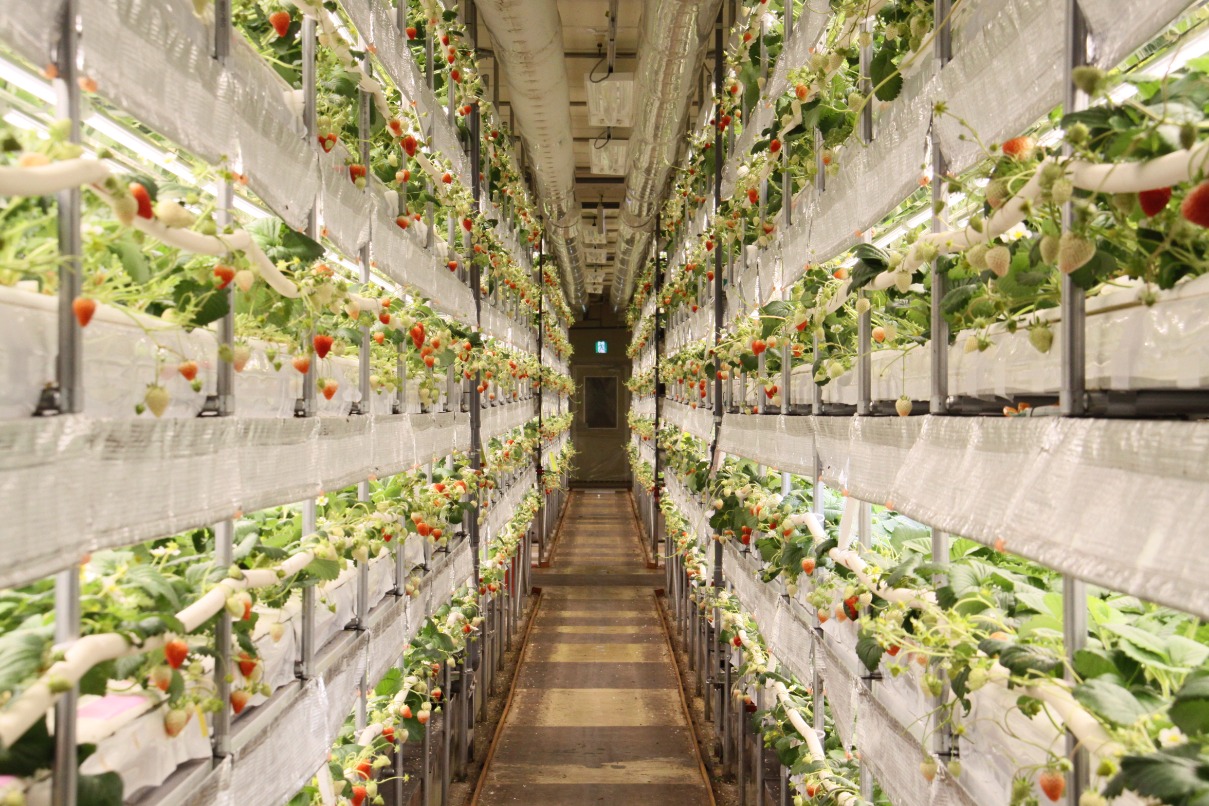
Installation of Photovoltaic Equipment
Ueda Japan Radio Co., Ltd., installed a photovoltaic system on the folded-plate roof of Building No. 126 at the headquarters plant as a means of achieving its greenhouse gas emissions reduction targets.
Panel capacity is 104.5 kW (550 W x 190 panels), CS 69.5 kW (power 20 kW electric light 4.95 kW x 10 units) and expected annual power generation is 126,876 kWh. In the first six months after installation, 18.1 MWh of electricity was generated, and 8 t-CO2 of greenhouse gas emissions were reduced.
A monitor displaying the amount of electricity generated has been installed at the entrance to Building 127 to attract the attention of employees and customers visiting the office. The visible state of the photovoltaic power generation equipment, an environmental measure, has had other effects besides power generation, such as improving the company's image externally, and internally, helping to raise employees' environmental awareness and interest in saving electricity. The company will continue its environmental activities through energy conservation in the future.
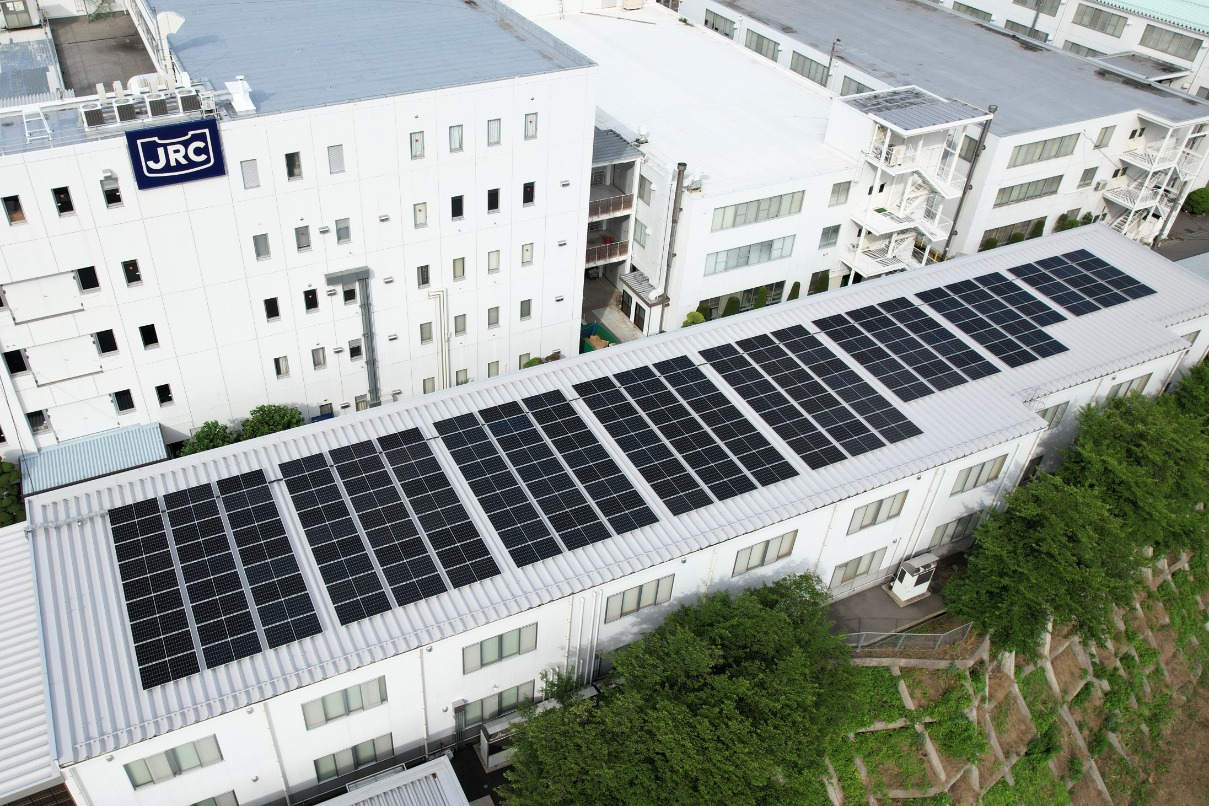
Start of Hydropower-Derived Renewable Electricity
Goyo Electronics Co., Ltd., is promoting the reduction of greenhouse gas emissions through company-wide efforts to reduce electricity, the main energy used, with the aim of achieving carbon neutrality.
In addition to this, the introduction of renewable energy from June 2024 will further accelerate the reduction of greenhouse gas emissions. At the Tsurunamadai and Sendai plants, 10% of the electricity used was switched to electricity from renewable energy derived from hydropower (Yorisou, Renewable Energy: Tohoku Electric Power). This resulted in a reduction in greenhouse gas emissions of 291 MWh and 137 t-CO2 in the amount of electricity from renewable energy sources for the period from June to December.
From April 2025, the proportion of electricity derived from renewable energy sources will be increased to 20%. The company will continue to contribute to the prevention of global warming and the achievement of carbon neutrality by introducing renewable energies in a phased manner.
Installation of PFCs and Other Gas Abatement Equipment
Nisshinbo Micro Devices Inc. uses greenhouse gases such as Perfluorocarbon gas (PFCs gas) in the manufacturing process of electronic device products.
Reducing emissions of PFCs gases is a key issue for the company in achieving carbon neutrality, and as a countermeasure, the company is introducing a detoxification system that decomposes PFCs gases.
The company installed one unit at the Kawagoe Plant in October 2024 and another at the Yashiro Plant in December 2024. At the Kawagoe Plant, combustion-type detoxification equipment was installed in the exhaust lines of three plasma CVD units that use a lot of C3F8 gas, which has a high global warming potential among PFCs gases.
At the Yashiro Plant, a plasma type detoxification system, which uses ultra-high temperature (nearly 2,000°C) plasma heat for decomposition and treatment, was adopted to increase the treatment capacity from dry type detoxification systems.
Greenhouse gas emissions were reduced by 5,880 t-CO2 in terms of CO2 from PFCs gas emissions at the Kawagoe Plant and by 3,615 t-CO2 at the Yashiro Plant.
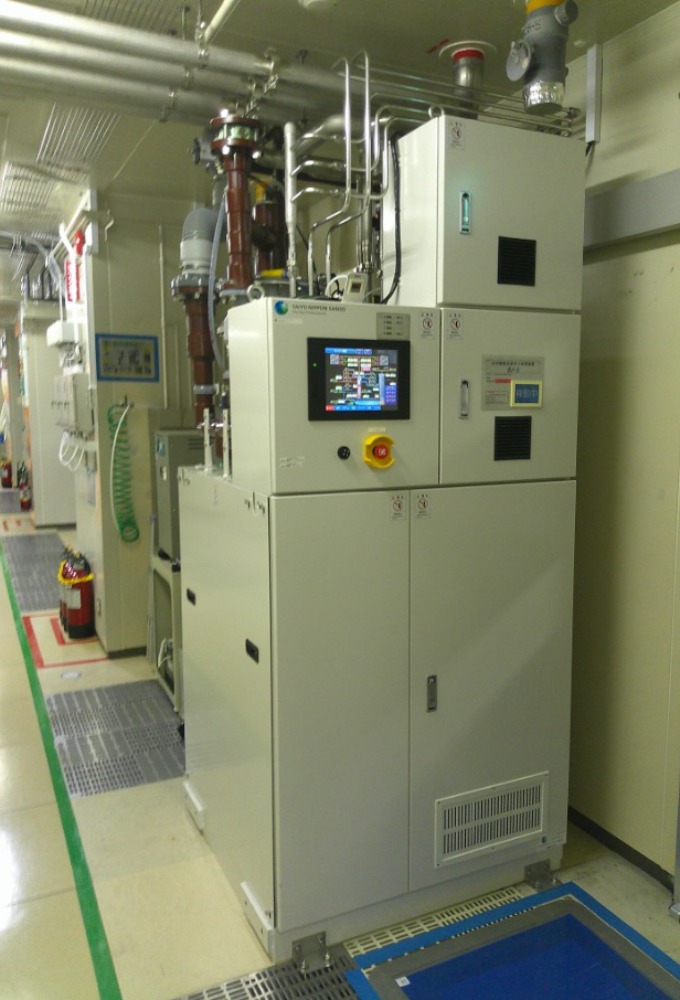
Promotion of Measures to Reduce Greenhouse Gases
With activities to achieve carbon neutrality becoming more active worldwide, demand is growing from automobile manufacturers to reduce greenhouse gas emissions.
Nisshinbo Automotive Manufacturing Inc. in the United States set a target of reducing greenhouse gas emissions by 4.2% annually based on the actual CO2 emissions for FY2019, and the company is actively promoting reduction activities. As part of these efforts, Nisshinbo Automotive Manufacturing has implemented carbon offsetting by purchasing 2,889 t-CO2 of carbon credits while utilizing renewable energy. In FY2024, the company achieved a total reduction of approximately 4,500 t-CO2 in greenhouse gas emissions.
Expansion of photovoltaic systems
In China, Nisshinbo Saeron (Changshu) Automotive Co., Ltd. installed solar power generation equipment on the roofs of its office building and guardroom, which has been in operation since October 2024.
The installation of photovoltaic power generation equipment is very popular in China. The company also considered installing solar power generation equipment and initially aimed to install it on the roofs of the factory building and the product warehouse, but as a result of investigations, the company decided against installation in these areas because of changes in Chinese building regulations. Subsequently, in order to contribute to achieving carbon neutrality, the company decided to change its plans and aim to install photovoltaic installations in limited spaces.
As a result, a photovoltaic system was installed, albeit with a small power output of 70 kW. Although the amount of electricity generated increases or decreases depending on the weather and sunshine hours, the system can generate enough electricity to power the company's daytime interior lighting. The amount of electricity generated can be checked at the entrance to the office building and when employees go to the canteen. In addition to the office building and the guardhouse, solar panels are also installed on each of the outside lights so that the power for the outside lights is also provided by solar energy.
The company will continue its efforts to achieve carbon neutrality in the future.
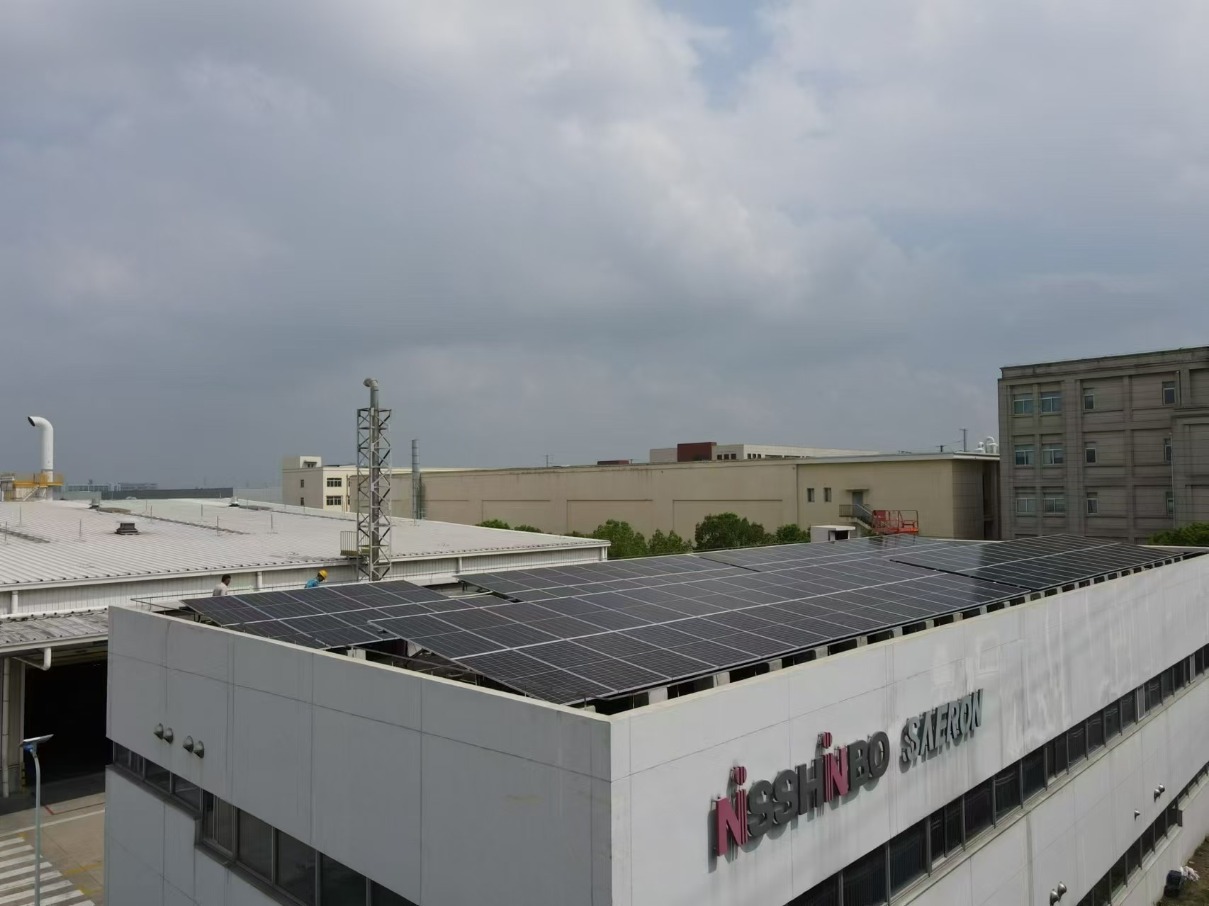
Expansion of Solar Power Generation Equipment for Self-Consumption
Nisshinbo Precision Instrument & Machinery Hiroshima Corp. expanded its solar power generation system for internal use in July 2024.
The 1,000 kW solar power generation system installed in 2015 for selling electricity has been expanded with the addition of a 100 kW solar power generation system for self-consumption (545 W modules × 272 panels, PCS 100 kW), which brings the total installed solar panel capacity to 1,100 kW. The annual power generation target is 1,100 MWh for power sales and 173 MWh for self-consumption, totaling 1,273 MWh.
Self-consumption power generation covers 5.7% of the company's total electricity consumption and provides almost all of the electricity needed on holidays with a high self-consumption rate of 95%. In addition, a 24-hour monitoring service provided by the construction company ensures that any problems can be addressed quickly.
Because of structural limitations, installing the equipment on the factory roof was not possible. Therefore, the equipment was installed on the slope near the property boundary. Consideration of a new power generation system for future expansion will be necessary because of the limited installation space. The company will continue to promote its activities while closely monitoring market trends for new solar panels.
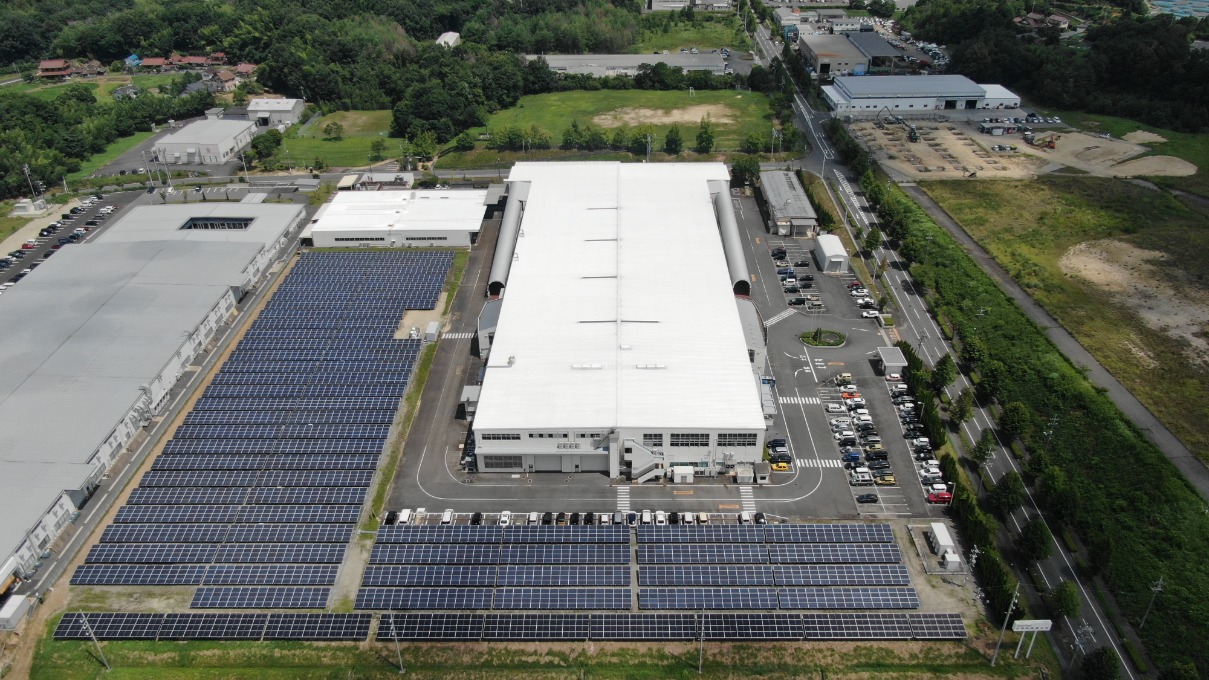
Upgrading to non-fluorocarbon refrigeration units
Nisshinbo Do Brasil Industria Textil LTDA. is progressively replacing old refrigeration units that use CFC gas as a refrigerant with new ones that use non-CFC refrigerants.
The conventional refrigeration units used to control the temperature and humidity in the plant use CFC R22 as a refrigerant, and while in use, a small amount of this CFC gas is released into the atmosphere, which makes the equipment highly hazardous environmentally.
The refrigerant HFO-1233zd in the new chillers recently renewed is nonflammable, nontoxic, and has a global warming potential of 1, making it an extremely low environmental impact facility.
The company has six refrigeration units, including a spare unit, and completed the renewal of the second unit in 2024. The company will continue to renew old equipment and increase its corporate value in order to transform itself into a production plant that is sustainable in all aspects.
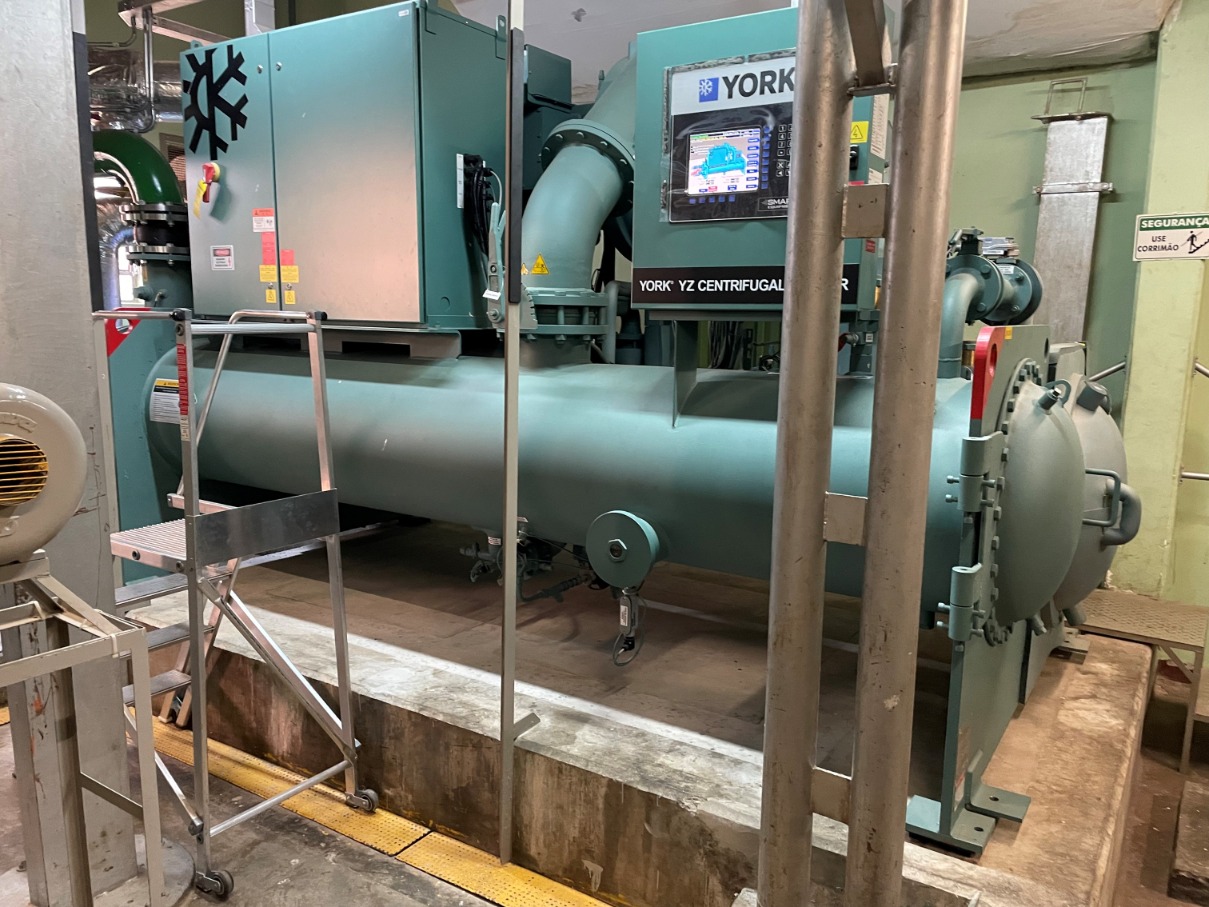
Renewal of air-conditioning systems for air-conditioning
PT. Naigai Shirts Indonesia is replacing the refrigerant in its air-conditioning units from CFC gas R22 to the environmentally friendly CFC R410A as part of its environmentally friendly initiatives. Since it is not possible to replace only the refrigerant, existing air-conditioning units are being replaced one by one with R410A-compatible equipment.
The use of R22 is internationally restricted as a refrigerant that can deplete the ozone layer. Therefore, the company aims to reduce its environmental impact and ensure sustainable operation by upgrading to new air conditioners that use R410A.
As of 2024, approximately 12% of the air conditioning systems in the company have already been replaced with new R410A-compliant air conditioners, and the remaining air conditioners are being replaced in due course.
